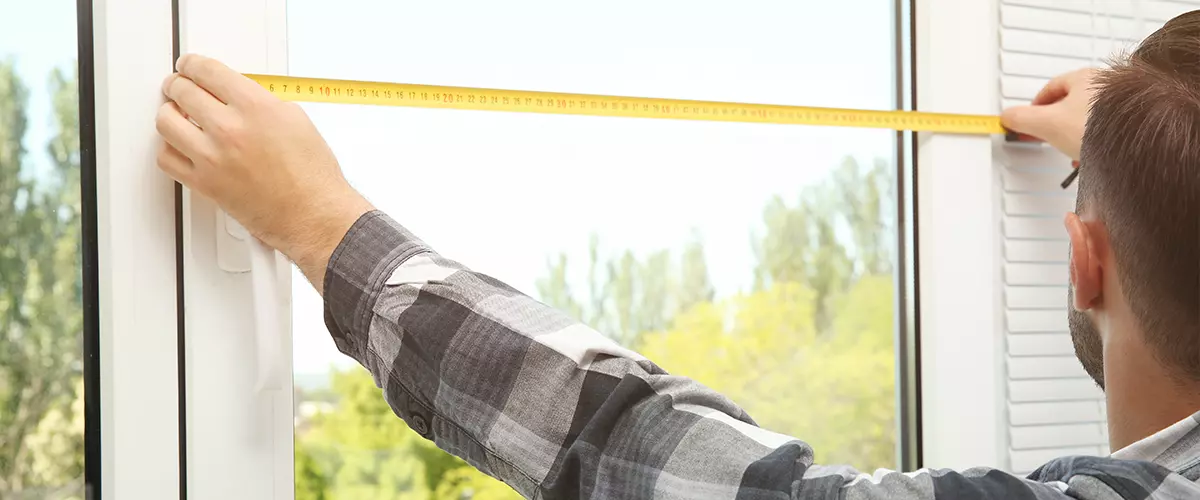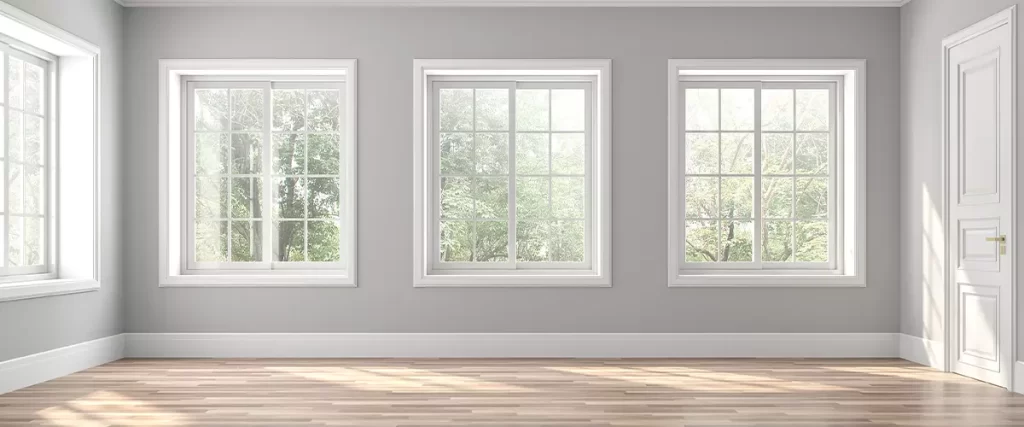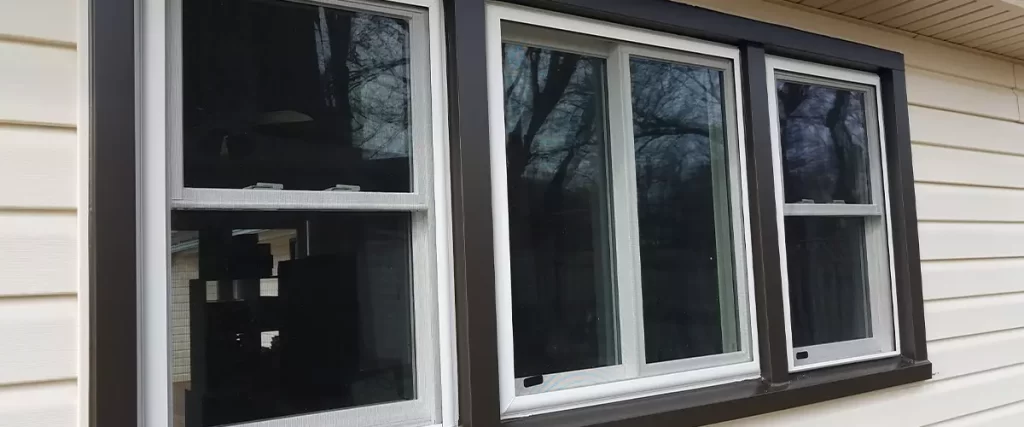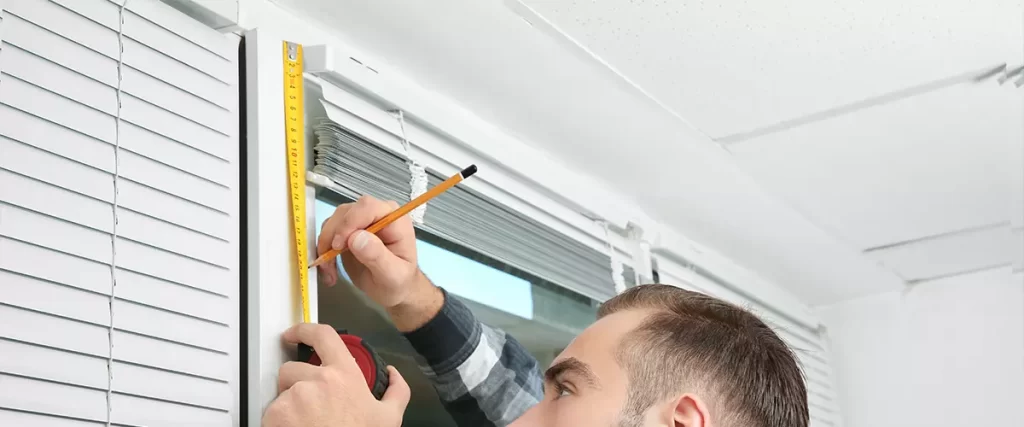You’ve decided to start a window replacement project, but you want to know what you should look for in terms of sizes and prices? You can estimate the cost of your replacement window if you know how to measure it right.
This quick five-step guide will show you how to measure for a replacement window with ease and accuracy.
You’ll need:
- Tape measure
- Level
- Paper and pen

How To Measure The Window Opening In 5 Steps
Price replacement window measurements are key to a seamless replacement window installation. Measuring for a replacement window doesn’t have to be overwhelming—just grab your tape measure, and let’s get started:
Check For Squares
Before you grab your tape measure for windows, making sure that the window frame angles are square is crucial. If the corners of your opening don’t form 90-degree angles, a replacement window won’t fit properly.
To do this, measure diagonally from corner to corner. Both diagonal measurements should be identical. Use a carpenter’s square to double-check those corners. Slide it into each corner and look for gaps between the tool and the frame materials.
A non-square frame will require adjustments or additional fitting tips during installation, so identifying this issue early can save time down the line when measuring for new windows or planning your home improvement project.
Make Sure The Frame Is Plumb
Ensuring your window frame is plumb means checking that the sides are perfectly vertical. This step is vital for the correct fitting of your replacement window, as an unlevel frame can lead to trouble during installation and future performance issues.
Use a level or plumb bob to check both sides of the window opening. If either side is not straight up and down, make a note of it; you may need shims or adjustments during the installation process.
If adjustments are necessary, do them carefully to avoid distorting the shape of the rough opening required for your new windows.
Make Sure the Opening Is Level
To guarantee your new windows fit perfectly, it’s crucial to check that the window opening is level. A spirit level will be your go-to tool for this task. Place the level on the bottom of the window opening and observe the bubble indicator; it should rest between the lines to indicate a true horizontal surface.
If it doesn’t, you may need to make adjustments or plan for shims during installation.
Use shims if necessary to achieve a level base before measuring window dimensions. This step ensures that both sashes of a vinyl replacement window operate smoothly and seal tightly once installed.
Measure window width
After checking that the opening is level, grab your tape measure for the next crucial step. Stand facing the window and extend the tape measure from one side of the window frame to the other.
Hold it straight across at about chest height to measure the width properly. Write this number down carefully; it’s essential for finding a replacement window that fits perfectly.
Next, you’ll need to measure different areas along with the width since walls can be uneven or out of square. Measure the bottom, middle, and top sections of the opening. Use these dimensions when selecting your new windows to ensure you’re considering any variations in wall construction when choosing your replacement window size.
This helps avoid surprises during installation and ensures your new windows look great and function properly once in place.
Measure window height
Now that you’ve determined the width of your window opening, it’s time to measure the height. Stand squarely in front of the window and extend your tape measure from the sill at the bottom straight up to the head of the window, where it meets the top structure.
Ensure your tape remains perfectly vertical for an accurate reading. Repeat this process at both ends and in the middle of your window; sometimes, older homes have settled, causing variations in measurements.
Grab a notepad to jot down these numbers—precise recording is vital for getting a perfect fit for your replacement windows. If there are discrepancies between heights, use the smallest measurement when ordering a new window.
This will guarantee that your new pane will fit into all parts of your current frame without creating gaps or requiring extensive modifications during installation.

Tips for Measuring
Measure Windows In Multiple Points
Measuring multiple points is essential when sizing up for a replacement window. Houses settle over time, and opening dimensions may vary slightly from top to bottom or side to side.
Use your tape measure at the top, middle, and bottom of the window frame for width. Do the same along both sides and the middle for height. Always use the smallest measurements to ensure your new window fits into the rough opening.
Ensure accuracy by checking each point twice; mistakes can be costly in both time and materials.
Consider Filler Pieces For Window Frames
In some cases, your replacement window won’t be an exact fit for the existing opening. This is where filler pieces come into play to bridge any gaps. They help ensure a snug and secure installation, keeping drafts out and energy efficiency in.
For vinyl windows, you may need horizontal or vertical fillers if the new unit is smaller than the rough opening. Trim these additions to match your interior for a seamless look that complements your home improvement efforts.
Always keep functionality in sync with aesthetic appeal while sizing up for that perfect window upgrade.
Measure Window Sash, Trim, And Sills Of Existing Window
After factoring in any necessary filler pieces, focus your attention on the trim and sills for accurate window measurement. Measure from the outside edges of the existing trim to obtain the full dimensions that include these decorative elements.
This ensures you account for any extra width or height the trim contributes to overall window size when shopping for replacement windows.
Use a reliable tape measure to determine the sill depth by measuring from the inside face of the window jamb to where it meets with your home’s exterior wall.
Take into account the slope and alignment of the wall
Moving beyond the window itself, it’s essential to evaluate the wall where your new windows will sit. Walls can be uneven due to settling or construction variances, affecting how you measure for that perfect fit.
Use a level to determine if there’s any tilt in the walls — even a slight slope can throw off your window measurements and ultimately impact installation.

Why You Shouldn’t Do These Alone
We’re not trying to pitch our services, but we are trying to help you get a home upgrade that pays off.
If you’re not experienced with precise measurements, you’re better off working with a professional. Here at CB Remodels, we can take care of the entire project for you, including measurements, shopping for materials, installation, and even clean-up after the job is done.
We’ve been doing remodels for homeowners in Pasadena, CA, for years now, and we can take care of you without you having to move a muscle. And although it’s hard to determine the cost of the new replacement windows, we’ll make sure to give you an accurate estimate based on window depth, type, frame, and materials.
Besides, wouldn’t you rather get a quality window installation and now a poor DIY project that fails to accomplish what you were going for?

Conclusion
You know the saying: “measure twice, cut once.”
But instead of risking your money and time and taking the wrong measurements, why not let an expert do it for you?
Get a professional to take the correct measurements and ensure your new windows are installed properly without sacrificing anything. If you’ve decided to try it on your own, measure very carefully and use a reliable tape measure for it. Obviously, if you have multiple windows, measure each one of them.
If you need help with a new construction window or repairing an existing frame, give us a call at (626) 598-0833 or request a free quote from this page.
